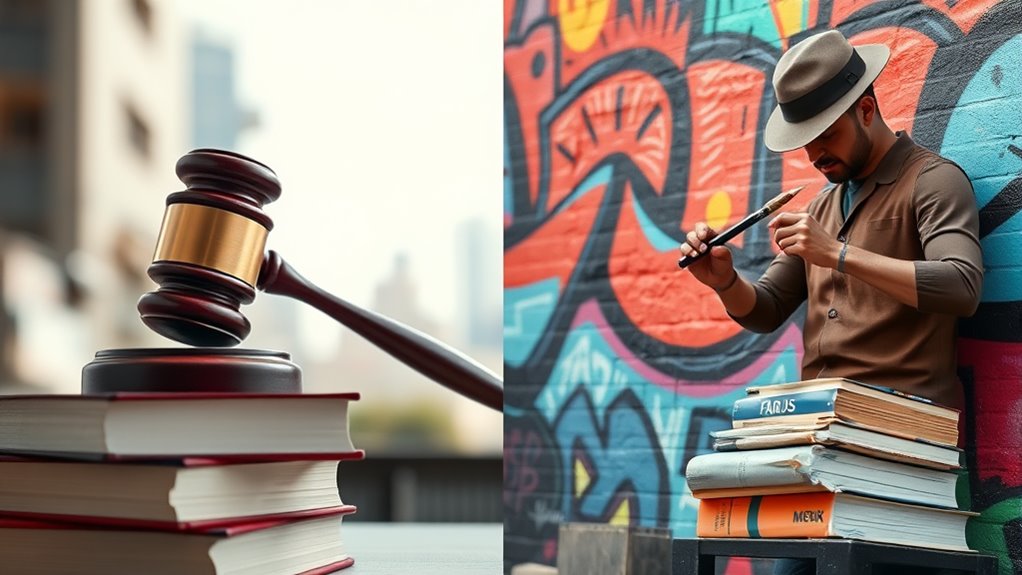Copyright protects your original work by giving you exclusive rights over its use, reproduction, and distribution. However, fair use allows limited use of copyrighted material without permission, primarily for commentary, education, or critique. There are four factors to evaluate when examining fair use, such as the purpose, nature, amount used, and market impact. Understanding these principles is vital for creators and users alike, and there’s more to explore on steering these concepts effectively.
Key Takeaways
- Copyright grants exclusive rights to creators over their original works, preventing unauthorized use and promoting creativity.
- Fair use allows limited use of copyrighted material without permission, evaluated on purpose, nature, amount, and market impact.
- The four factors of fair use include the purpose of use, nature of the work, amount used, and market effect.
- Creative Commons licenses clarify the permissions for sharing content while maintaining creator rights, supporting collaboration.
- Balancing copyright and fair use fosters creativity while respecting intellectual property and encourages responsible digital sharing practices.

When you create something original, understanding the difference between copyright and fair use is essential. Copyright gives you exclusive rights over your work, allowing you to control how it’s used, reproduced, or distributed. This protection kicks in as soon as your work is fixed in a tangible form, like a written document, a painting, or a digital file. Knowing this, you can safeguard your intellectual property and prevent others from using it without your permission. But what if someone else wants to use a part of your work? That’s where the concept of fair use comes into play.
Understanding copyright and fair use is crucial for protecting your original work and managing how others can utilize it.
Fair use is a legal doctrine that permits limited use of copyrighted material without needing permission from the rights holder. It’s a bit tricky, though; fair use isn’t a blanket rule. Courts consider four factors when determining if a use qualifies as fair: the purpose of the use, the nature of the copyrighted work, the amount used, and the effect on the market value of the original work. For instance, using a small excerpt from a book for commentary or critique often falls under fair use. However, if you’re making a profit from that use, it might not be considered fair.
In today’s digital landscape, understanding your digital rights is essential. You might come across Creative Commons licenses that can help clarify how others can use your work. These licenses allow you to set specific permissions for your content, enabling sharing while still protecting your rights. You can choose to allow others to use your work for non-commercial purposes, or even require attribution. By using Creative Commons, you can maintain control over your intellectual property while encouraging creativity and collaboration.
Navigating copyright and fair use can seem intimidating, but it’s essential for anyone involved in creative work. It’s not just about protecting your own rights; understanding these concepts also helps you respect the rights of others. When you’re aware of the boundaries, you can create and share with confidence. Remember, while copyright protects your work, fair use can provide opportunities for dialogue and innovation. Additionally, creators can benefit from understanding Leave No Trace principles, which promote responsible sharing and use of resources. So, educate yourself on these topics, utilize tools like Creative Commons, and be mindful of your digital rights. In the end, knowing how to balance these elements can empower you as a creator in the ever-evolving digital world.
Frequently Asked Questions
What Types of Works Are Eligible for Copyright Protection?
Creative works like books, music, films, and artwork are eligible for copyright protection. If you’ve created something that showcases original authorship, it’s likely protected. This includes written text, visual art, and software code, among others. You’ve put your unique spin on your ideas, so you deserve recognition. Remember, copyright safeguards your right to control how others use your work, ensuring you get the credit you deserve for your creativity.
How Long Does Copyright Protection Last for Different Works?
Think of copyright protection like a garden; it needs care and attention. For most works, it lasts for the creator’s lifetime plus 70 years, ensuring their legacy blooms long after they’re gone. Some works, like corporate creations, may have a shorter duration of protection—typically 95 years from publication. Remember, renewal requirements can sometimes apply, so keeping an eye on those deadlines is essential to maintaining your creative rights.
Can I Register a Copyright for My Work After Publishing It?
Yes, you can register a copyright for your work even after publishing it. In fact, doing so strengthens your legal protections. Just remember, once your work’s published, it’s not automatically in the Public Domain, and you can still choose to apply a Creative Commons license if you want to allow certain uses. Registering your copyright helps you assert your rights and take action if someone infringes on your work.
What Are the Penalties for Copyright Infringement?
If you infringe on copyright, you could face significant monetary penalties and legal consequences. These can include hefty fines, damages, and even the potential to pay the copyright holder’s legal fees. In severe cases, you might also deal with criminal charges, leading to imprisonment. It’s vital to understand that protecting someone’s intellectual property is taken seriously, so always make certain you have permission before using someone else’s work.
How Can I Determine if My Use Qualifies as Fair Use?
To determine if your use qualifies as fair use, consider if it’s transformative. Did you add new meaning or purpose? About 30% of copyright cases hinge on this aspect. Next, evaluate the commercial impact; if your use competes with the original work, it’s less likely to be fair use. Ultimately, think about the nature of the original work and the amount you’re using. Balancing these factors helps clarify your fair use claim.
Conclusion
In understanding copyright and fair use, it’s vital to know that while copyright protects creators’ rights, fair use allows for certain exceptions. Did you know that about 80% of people mistakenly believe they can use copyrighted material freely under fair use? This misconception can lead to serious legal issues. By grasping the basics of these concepts, you’re better equipped to navigate the creative landscape responsibly and respect the rights of others while expressing your own ideas.










